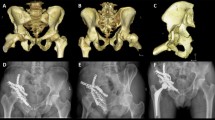Abstract
Purpose
Delayed surgical management of acetabular fractures, often necessary due to life-threatening concomitant injuries, is a great challenge because delays may potentially increase complications and decrease outcomes. We report clinical outcomes of 61 acetabular fractures treated by delayed open reduction and internal fixation (ORIF) with an injury-to-surgery interval (ISI) of 22–399 days.
Methods
Operations were performed between April 2001 and December 2008. There were 61 cases (42 men 19 women), with an average age of 38 years. All patients were followed for an average of 82 months. Demographic data, fracture pattern, ISI, concomitant injuries, surgical approach, complications and clinical outcomes were recorded and analysed. There were 16 simple fractures (26.2 %) and 45 associated fractures (73.8 %). Matta criteria were used to evaluate reduction quality. The Merle d’Aubigné and Postel scoring system was employed to assess post-operative functionality.
Results
Anatomical reduction was achieved in 45 cases (73.8 %). The clinical result was excellent in 38 cases, good in 13, fair in six and poor in four. Osteonecrosis of the femoral head was observed in three cases, and heterotopic ossification was found in 28 cases. Four patients had transient palsy of the sciatic nerve.
Conclusions
ORIF for fresh acetabular fractures might yield a better prognosis; however, for delayed acetabular fractures, clinical outcomes are also predictable when sophisticated surgical techniques are employed. Our results indicate that delayed ORIF could yield satisfactory clinical outcomes in the majority of patients with acetabular fractures.



Similar content being viewed by others
References
Vallier HA, Cureton BA, Patterson BM (2013) Factors affecting revenue from the management of pelvis and acetabulum fractures. J Orthop Trauma 27:267–274
Tannast M, Najibi S, Matta JM (2012) Two to twenty-year survivorship of the hip in 810 patients with operatively treated acetabular fractures. J Bone Joint Surg Am 94:1559–1567
Lunsjo K, Tadros A, Hauggaard A, Blomgren R, Kopke J, Abu-Zidan FM (2007) Associated injuries and not fracture instability predict mortality in pelvic fractures: a prospective study of 100 patients. J Trauma 62:687–691
Giannoudis PV, Bircher M, Pohlemann T (2007) Advances in pelvic and acetabular surgery. Injury 38:395–396
Johnson EE, Matta JM, Mast JW, Letournel E (1994) Delayed reconstruction of acetabular fractures 21-120 days following surgery. Clin Orthop Relat Res 305:20–30
Zhu S, Sun X, Yang M, Li Y, Zhao C, Wu H, Cao Q, Wu X, Wang M (2013) Long-term outcome of operative management of delayed acetabular fractures. Chin Med J 126:2699–2704
Lichte P, Sellei RM, Kobbe P, Dombroski DG, Gänsslen A, Pape HC (2013) Predictors of poor outcome after both column acetabular fractures: a 30-year retrospective cohort study. Patient Saf Surg 7:9
Brueton RN (1993) A review of 40 acetabular fractures: the importance of early surgery. Injury 24:171–174
Zha GC, Sun JY, Dong SJ (2013) Predictors of clinical outcomes after surgical treatment of displaced acetabular fractures in the elderly. J Orthop Res 31:588–595
Madhu R, Kotnis R, Al-Mousawi A, Barlow N, Deo S, Worlock P, Willett K (2006) Outcome of surgery for reconstruction of fractures of the acetabulum. The time dependent effect of delay. J Bone Joint Surg (Br) 88:1197–1203
Letournel E (1980) Acetabulum fractures: classification andmanagement. Clin Orthop Relat Res 151:81–106
Judet R, Judet J, Letournel E (1964) Fractures of the acetabulum: classification and surgical approaches for open reduction. J Bone Joint Surg Am 46:1615–1675
Matta JM (1996) Fractures of the acetabulum: accuracy of reduction and clinical results in patients managed operatively within three weeks after the injury. J Bone Joint Surg Am 78:1632–1645
Matta JM, Anderson LM, Epstein HC, Hendricks P (1986) Fractures of the acetabulum. A retrospective analysis. Clin Orthop Relat Res 205:230–240
d’Aubigne RM, Postel M (1954) Functional results of hip arthroplasty with acrylic prosthesis. J Bone Joint Surg Am 36:451–475
Brooker AF, Bowerman JW, Robinson RA, Riley LH Jr (1973) Ectopic ossification following total hip replacement. Incidence and a method of classification. J Bone Joint Surg Am 55:1629–1632
Briffa N, Pearce R, Hill AM, Bircher M (2011) Outcomes of acetabular fracture fixation with ten years’ follow-up. J Bone Joint Surg (Br) 93:229–236
Magill P, McGarry J, Queally JM, Morris SF, McElwain JP (2012) Minimum ten-year follow-up of acetabular fracture fixation from the Irish tertiary referral centre. Injury 43:500–504
Uchida K, Kokubo Y, Yayama T, Nakajima H, Miyazaki T, Negoro K, Takeno K, Sawaguchi T, Watanabe S, Sugita D, Takeura N, Yoshida A, Baba H (2013) Fracture of the acetabulum: a retrospective review of ninety-one patients treated at a single institution. Eur J Orthop Surg Traumatol 23:155–163
Mears DC, Velyvis JH, Chang CP (2003) Displaced acetabular fractures managed operatively: indicators and outcome. Clin Orthop Relat Res 407:173–186
Katsoulis E, Giannoudis PV (2006) Impact of timing of pelvic fixation on functional outcome. Injury 37:1133–1142
Brueton RN (1993) A review of 40 acetabular fractures: the importance of early surgery. Injury 24:171–174
Prevezas N (2007) Evolution of pelvic and acetabular surgery from ancient to modern times. Injury 38:397–409
Bishop JA, Routt ML (2012) Osseous fixation pathways in pelvic and acetabular fracture surgery: osteology, radiology, and clinical applications. J Trauma Acute Care Surg 72:1502–1509
Issack PS, Helfet DL (2009) Sciatic nerve injury associated with acetabular fractures. HSS J 5:12–18
Giannoudis PV, Grotz MR, Papakostidis C, Dinopoulos H (2005) Operative treatment of displaced fractures of the acetabulum. A meta-analysis. J Bone Joint Surg (Br) 87:2–9
Prasartritha T, Chaivanichsiri P (2013) The study of broken quadrilateral surface in fractures of the acetabulum. Int Orthop 37:1127–1134
Conflict of interest statement
We declare that we have no conflict of interest.
Author information
Authors and Affiliations
Corresponding author
Additional information
You-Shui Gao and Zu-Bin Zhou contributed equally to this work.
Rights and permissions
About this article
Cite this article
Gao, YS., Zhou, ZB., Tang, MJ. et al. Late surgery for acetabular fractures in a Chinese level I trauma centre: surgical experience and outcomes. International Orthopaedics (SICOT) 39, 1865–1871 (2015). https://doi.org/10.1007/s00264-015-2932-2
Received:
Accepted:
Published:
Issue Date:
DOI: https://doi.org/10.1007/s00264-015-2932-2




